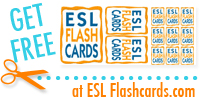
Mar 9th, 2013, 01:52 pm
|
| eslHQ Member | | Join Date: Oct 21st, 2012
Posts: 10
| |
 Games for teaching sentences to big groups Games for teaching sentences to big groups
Hi there
I'm going to teach 1st - 4th graders very soon. What we have is a storybook and the rest is up to me. The group size will be around 40 students and each class (1½ hour) I will be teaching one chapter of the book.
Now, I could really use some games or tools to use when teaching this way. I used to teach kindergarteners where the material were quite different and much based around flashcard-games which is not the case this time.
What kind of activities or tools can I use for teaching sentences to such big groups?
Thank you. |












 Threaded Mode
Threaded Mode


